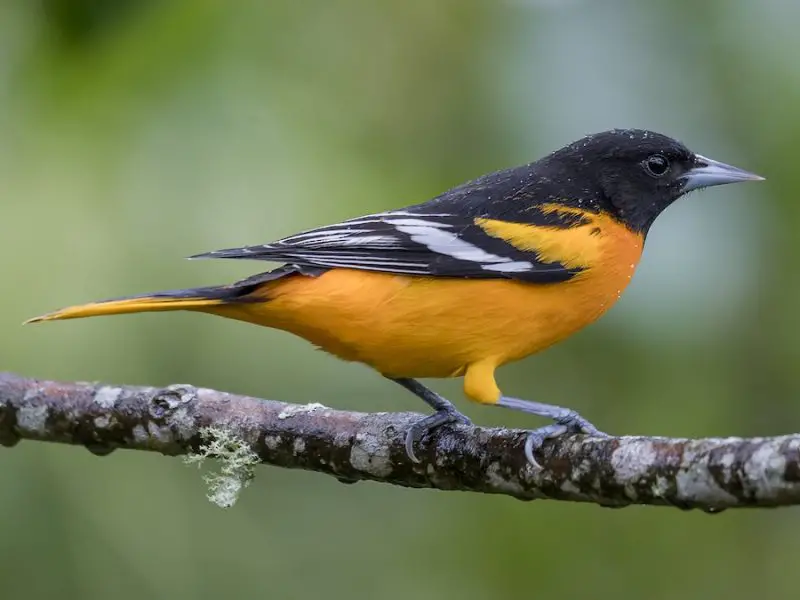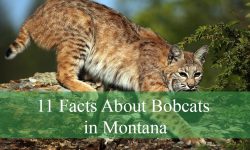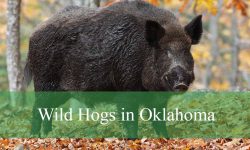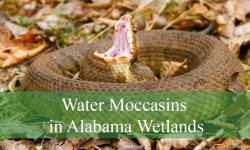Orioles stand out easily in Florida’s birdlife, not just for their bright plumage but also for their smooth, musical calls and the way they move effortlessly between natural habitats and busy suburban areas. While many people recognize them for their bright plumage, far fewer understand the unique traits that allow orioles to thrive across the Sunshine State. Florida’s broadleaf forests, citrus groves, wetlands, and residential gardens all serve as seasonal homes for these energetic birds.
This article explores ten hidden characteristics of Florida orioles that most people never hear about. Each fact provides insight into their feeding habits, migration strategies, nesting behavior, and ecological value. Below are ten fascinating traits that reveal why orioles continue to be a beloved part of Florida’s avian community.
1. Florida Hosts Multiple Oriole Species

Different species visit or reside in Florida
Many people assume Florida has only one oriole species, but the state actually hosts several that vary in behavior and seasonal presence. The most frequently encountered are the Baltimore Oriole, Orchard Oriole, and the non-native Spot-breasted Oriole. Their use of Florida’s landscapes depends on their migratory tendencies, climate tolerance, and food preferences.
Baltimore Orioles, for example, are common winter visitors. They arrive when temperatures fall in the northern states and take refuge in Florida’s warmer zones. Their bright colors make them easy to recognize, but they often stay hidden in canopy layers where food sources are abundant.
Orchard Orioles appear mainly during migration, stopping briefly to refuel on nectar and insects before continuing toward their northern breeding territories. They tend to remain less visible because they feed quickly and move on, rarely settling in any one location for long.
Spot-breasted Orioles, in contrast, behave like true Floridians. Originally introduced from Central America, they have established permanent breeding populations in southern cities where tropical foliage and warm temperatures mimic their native environment. Their presence is a unique aspect of Florida’s avian biodiversity.
Migration status varies by species
Baltimore Orioles are long-distance migrants that often arrive in late fall and stay through early spring. Their migration depends heavily on seasonal fruiting cycles and the availability of nectar-producing trees. When temperatures rise, most of them continue northward to breed, though a few may linger in southern Florida if food remains abundant.
Orchard Orioles follow a different pattern. They migrate in distinct waves, often seen feeding intensely for a day or two before disappearing. These brief stopovers are timed with insect emergence and flowering events that provide the energy needed to complete their flight.
Spot-breasted Orioles break the mold. Unlike the others, they stay in Florida year-round and have become part of the local ecosystem. Their distribution is still limited, but slowly expanding, especially as urban landscaping and warm climates create more suitable habitats.
Because each species interacts with Florida differently, understanding their presence helps birdwatchers know when and where to look for them.
2. Orioles Prefer Florida’s Flowering Trees Over Fruit Trees
Nectar sources play a major role in their diet
Many people associate orioles primarily with fruits, but in Florida, nectar often holds greater importance. The state’s warm climate encourages extended blooming seasons, giving orioles access to nectar nearly year-round. Bottlebrush, coral bean, red silk-cotton, and coral honeysuckle are some of the trees and shrubs orioles rely on most heavily.
These nectar-rich plants produce high-energy sugars that fuel the birds during migration, territory establishment, and long daily foraging flights. Florida’s abundant floral resources also help orioles maintain better body condition compared to populations in regions with shorter bloom periods.
During peak migration, orioles often concentrate in areas with dense flowering trees. Observers frequently report seeing multiple individuals feeding on the same tree, especially in coastal zones where nectar availability remains high.
This preference for nectar makes certain residential neighborhoods surprisingly attractive to orioles, particularly those with vibrant landscaping and native flowering species.
Their tongue structure helps extract nectar efficiently
Orioles possess a specialized brush-tipped tongue that spreads into fine filaments at the tip. This adaptation allows them to lap up nectar with remarkable efficiency, sweeping the liquid quickly from deep flowers. Their tongues retract rapidly between strokes, enabling them to feed continuously without losing precious energy.
This unique structure is one of the main reasons orioles can exploit nectar sources better than many other songbirds, including species that attempt to feed opportunistically from the same flowers.
While they still consume fruits such as oranges, mulberries, and papayas, nectar remains a critical resource during Florida’s spring bloom cycles. The high sugar concentration helps orioles maintain stable metabolism during the stress of migration.
Birdwatchers who want to attract orioles in Florida often succeed simply by planting nectar-producing trees rather than relying on fruit feeders alone.
3. Florida Orioles Rely Heavily on Insects During Breeding Season
Protein intake increases dramatically
When orioles prepare to breed, their dietary priorities undergo a sharp shift. Instead of focusing on nectar and fruit, they begin consuming insects at a much higher rate. Caterpillars, beetles, spiders, and flying insects become the primary sources of protein needed for egg formation, muscle development, and prolonged activity during nest construction.
This protein-heavy diet is essential because raising chicks demands constant energy expenditure. Nestlings require rapid growth, and insects are the most efficient source of amino acids necessary for building feathers, muscles, and internal organs.
During this period, orioles spend more time foraging in canopy layers, searching for insect clusters hidden under leaves or bark. Florida’s warm, humid climate causes caterpillar populations to surge at the perfect time, allowing orioles to feed almost continuously.
As a result, the timing of Florida’s insect cycles plays a direct role in the reproductive success of oriole pairs.
Insects influence where orioles choose to nest
Because insects are so crucial during breeding season, orioles tend to nest in zones where caterpillar outbreaks occur. Mature oaks, cypress stands, and mixed hardwood forests create ideal insect-rich environments. The availability of these foraging sites can cause orioles to shift territories between years.
In areas where insect populations decline—due to drought, pesticide use, or habitat disturbance—orioles may abandon their usual breeding locations entirely.
Florida’s naturally high insect diversity typically works in their favor. Spiders and beetles flourish in wetlands, pine flatwoods, and suburban gardens, giving orioles a broad range of potential nesting areas.
However, suburban pesticide use can significantly reduce insect availability. Regions with eco-friendly landscaping, native plants, and minimal chemical use often attract more orioles during the breeding months.
4. Orioles Build Intricate Hanging Nests in Florida
Their nests resemble woven baskets
Orioles are remarkable architects. Their nests, often described as pendulous or basket-like, are carefully woven structures that can withstand wind, rain, and Florida’s late-spring storms. These nests are typically constructed using thin plant fibers such as grasses, palm strands, Spanish moss, and even fishing line when available.
The female is primarily responsible for building the nest. She weaves layer after layer, reinforcing the inner cup while shaping a deep pocket that remains secure even when heavy rains fall.
In Florida, orioles commonly build these nests at the tips of branches in live oaks, bald cypress, and tall palms. The dangling position reduces access for many predators, forcing them to navigate thin, flexible branches that cannot support their weight.
Some orioles also incorporate man-made materials like string or yarn, especially in suburban areas where natural fibers may be limited.
Nest placements protect them from predators
Nest placement is not random. Orioles choose outer branches because predators like snakes, raccoons, and opossums have difficulty reaching them. This strategy significantly reduces nest predation, especially in forests where climbing mammals are common.
The elevation also helps regulate temperature inside the nest, allowing breezes to cool young birds during Florida’s hot afternoons.
Wind exposure may seem risky, but orioles compensate with meticulous weaving that secures the nest firmly. Over time, the structure stiffens, becoming resistant to shaking and tearing.
These nests provide perfect shelter for fledglings, giving them a safe place to grow until they are ready to begin short flights through the canopy.
5. Orioles Use Florida’s Mild Winters Strategically
Many orioles overwinter in the state
Florida’s mild winters offer ideal refuge for many orioles. While northern populations continue migrating into Central and South America, a considerable number choose to overwinter in Florida instead. The combination of warm temperatures and year-round food availability makes survival far easier than in the northern states.
Baltimore Orioles are especially common in winter, gathering in parks, orchards, and well-planted residential areas.
South Florida, with its subtropical climate, supports the largest overwintering numbers. These areas provide consistent nectar flow from tropical ornamental trees and flowering shrubs.
Warm winters also reduce the metabolic stress associated with cold-weather survival, allowing birds to conserve more energy for the upcoming migration.
Winter feeding habits differ from summer habits
During winter, orioles shift their diet toward fruits, berries, citrus, and nectar because insects become less abundant. Homeowners often notice orioles visiting hummingbird feeders or sugar-water stations when colder weather limits natural sugary foods.
Citrus trees, especially in central and southern Florida, become an important food source. Orioles pierce the fruit to drink the juice, absorbing both liquid and sugars.
Berries from firebush, American beautyberry, and native hollies are also heavily consumed. These winter diets provide the calories needed to maintain body mass when insects are scarce.
As spring approaches and insect numbers rise, orioles naturally transition back to protein-rich foods to prepare for breeding.
6. Orioles Show Regional Color Variations in Florida
Subtle plumage differences emerge in warm climates
Florida’s orioles often display color tones that differ slightly from individuals seen farther north. The combination of strong sunlight, varied diets, and prolonged exposure to warm climates influences pigmentation. Over time, these conditions can deepen the orange tones in Baltimore Orioles or enhance the chestnut coloration in Orchard Orioles.
Sun exposure plays a bigger role than many realize. Birds spending more time in open, exposed areas often develop richer colors due to the interaction between sunlight and carotenoid pigments in their feathers.
Diet also contributes to these subtle differences. Many Florida orioles feed heavily on carotenoid-rich fruits such as oranges, papayas, and certain berries. These pigments directly affect feather brightness, creating more vivid plumage in birds that remain in Florida longer.
Even wintering orioles can appear more saturated than individuals migrating through other states, simply because Florida provides more consistent access to pigment-rich foods.
Juveniles show even more variation
Young orioles confuse many birdwatchers due to their wide range of transitional plumage. Juvenile males often take two full years to develop the bright adult colors seen in mature individuals. During this period, their feathers shift in stages, producing patterns of yellow, olive, brown, or muted orange.
In Florida, where young birds experience longer feeding seasons and more sunlight, these transitional tones sometimes appear exaggerated compared to northern populations.
Juvenile Spot-breasted Orioles show particularly dramatic changes. Because this species is non-native and now adapting to Florida’s environment, variations in juvenile feathers occur more frequently as genetic mixing increases.
This broad range of plumage differences has made Florida an important location for researchers studying how climate and diet influence feather development.
7. Orioles Are Attracted to Florida Citrus Groves
Citrus blossoms are a major nectar source
Florida’s citrus groves act as natural magnets for orioles, especially during blooming seasons. Orange, grapefruit, and tangerine blossoms produce abundant nectar that orioles consume eagerly. Each flower offers high-energy sugars essential for fueling migration and breeding cycles.
Because citrus trees bloom at a time that aligns with major oriole migration waves, groves become reliable feeding hotspots that support birds when energy demands peak.
During early spring, long rows of blooming citrus trees can attract dozens of orioles at once. The birds move rapidly among blossoms, probing each flower with their brush-tipped tongues.
This consistent nectar availability is one of the main reasons migrating orioles follow routes that pass near Florida’s agricultural regions.
Citrus pests also become an unexpected food supply
Citrus groves support not only nectar production but also large populations of insects. Caterpillars, beetles, and leaf-feeding larvae thrive among citrus leaves, providing orioles with an additional source of protein.
This combination makes citrus orchards doubly valuable—offering both sugars for energy and insects for muscle development.
Orioles naturally help reduce pest populations as they forage. By consuming larvae and beetles, they contribute to lower crop damage without the need for chemical insecticides.
Farmers in south and central Florida often notice that orchards with regular oriole activity experience fewer outbreaks of leaf-eating pests.
Orioles also help remove scale insects and mealybugs that feed on citrus sap. This behavior supports the health of orchard trees and indirectly improves fruit quality across many groves.
8. Florida’s Spot-Breasted Orioles Have Unusual Origins
They are not native to North America
Spot-breasted Orioles stand out among Florida’s avifauna because they are not native to the United States at all. They originated in Central America and were introduced accidentally to Florida during the mid-20th century.
The earliest populations formed in Miami-Dade County, where warm temperatures, tropical landscaping, and consistent food sources provided near-perfect conditions for survival.
Over time, these birds adapted to suburban life remarkably well. They began nesting in residential areas, feeding on ornamental flowers, and thriving in environments shaped by human development.
Today, Florida remains the only state in the U.S. where Spot-breasted Orioles are found in established, self-sustaining populations.
Their range is slowly expanding
While originally confined to a small area in South Florida, Spot-breasted Orioles have gradually extended their range northward. Suburban corridors, newly planted tropical vegetation, and warming climate conditions have all contributed to this slow expansion.
Their movement is typically subtle, with small family groups gradually exploring new territories before establishing breeding clusters.
Their behavior also differs slightly from native orioles. They vocalize more frequently, remain more visible in residential gardens, and tolerate human presence more readily than migratory species.
These traits make Spot-breasted Orioles an ideal subject for researchers studying how non-native birds adapt to new ecological pressures and food landscapes.
In some areas, they compete lightly with Baltimore Orioles during winter months, though their year-round residency helps reduce direct conflict between the species.
9. Orioles Communicate With Surprisingly Complex Songs
They use a wide variety of notes and patterns
Orioles have far more complex vocal repertoires than most people realize. Their songs include clear whistles, soft chatter, rapid trills, and sharp alarm notes that can carry long distances through Florida’s open habitats.
These vocalizations help orioles establish territories, attract mates, and warn other birds of predators.
During migration and early breeding season, males often sing from high perches, allowing their calls to travel farther. Their voices must compete with the noise of insects, wind, and other birds, especially in Florida’s dense woodlands.
Each species also has its own unique sound signature, making it possible to identify an oriole by song even when hidden in foliage.
Song structure changes based on context
Male orioles sing more frequently during spring, when competition for breeding territories is highest. These songs tend to be longer and more elaborate, serving as both a territorial warning and a display of fitness.
Females, although quieter, use soft calls around the nest to communicate with mates and young.
Alarm calls differ significantly from mating calls. They often consist of sharp, repetitive notes used to alert nearby birds to snakes, hawks, or other dangers.
Floridian orioles, especially those in suburban areas, also adapt their songs to noisy environments by altering pitch or switching to more rapid sequences that cut through ambient sound.
Some researchers believe that Florida’s extended breeding conditions may result in slightly more vocal variation among orioles living in warmer climates.
10. Orioles Play an Important Ecological Role in Florida
They aid pollination across numerous plant species
While butterflies and hummingbirds are more famously associated with pollination, orioles quietly play a significant role in Florida’s flowering ecosystems. As they drink nectar, tiny grains of pollen cling to their forehead feathers, throat, and bill.
When the bird visits another flower, the pollen transfers, helping fertilize the plant and support fruit production.
This pollination service benefits native plants like coral bean, firebush, and various tropical ornamentals. Because orioles move widely across landscapes, they help maintain genetic diversity by spreading pollen over greater distances than insects alone.
Their long-range movements make them effective pollinators of species that bloom during migration seasons.
They help regulate insect populations
During breeding season, orioles consume thousands of insects, reducing pest populations naturally. Caterpillars, beetles, ants, and moth larvae all make up significant portions of their diet during warm months.
This consistent predation helps protect Florida’s forests, gardens, and agricultural lands from outbreaks.
Orioles also target insects harmful to citrus trees, including leaf miners, whiteflies, and various scale insects that damage leaves or transmit disease. Their feeding offers natural biological control that benefits orchard health.
Even in suburban neighborhoods, orioles contribute to ecological balance by keeping caterpillar populations manageable.
FAQs About Orioles in Florida
What is the most common oriole in Florida?
The most commonly seen orioles are the Baltimore Oriole in winter and the Spot-breasted Oriole in southeastern Florida.
Do orioles stay in Florida year-round?
Some do. Spot-breasted Orioles are permanent residents, while Baltimore Orioles overwinter in many parts of the state.
What do Florida orioles eat the most?
Their diet shifts seasonally, but they rely heavily on insects, nectar, fruits, and occasionally sugar-water feeders.
How can I attract orioles to my Florida yard?
Offer oranges, grape jelly, nectar feeders, and plant native flowering trees like bottlebrush or coral bean.
Do orioles harm fruit trees?
No, they mainly consume soft fruits or insects without damaging the tree itself.
When are orioles most active in Florida?
They are especially active during spring migration, late winter feeding periods, and early summer breeding cycles.
Where do orioles nest in Florida?
They build woven hanging nests in live oaks, cypress trees, palms, and sometimes well-established ornamental trees.
Are orioles protected in Florida?
Yes. Native orioles are protected under federal migratory bird regulations.
Why do orioles love citrus groves?
Because citrus blossoms offer nectar and the groves provide abundant insects.
Do Florida orioles migrate long distances?
Baltimore and Orchard Orioles migrate thousands of miles, though Spot-breasted Orioles stay local.
Final Thoughts
Orioles remain one of Florida’s most enchanting bird species, admired for their colors, calls, and impressive adaptability. Their seasonal movements, dietary flexibility, and unique nesting behaviors reveal how deeply connected they are to the state’s ecosystems. Whether visiting briefly during migration or residing year-round, orioles continue to enrich Florida’s natural landscapes in subtle but meaningful ways. Understanding their hidden characteristics deepens appreciation for the wildlife that thrives among the trees, wetlands, and suburban gardens of the Sunshine State.






